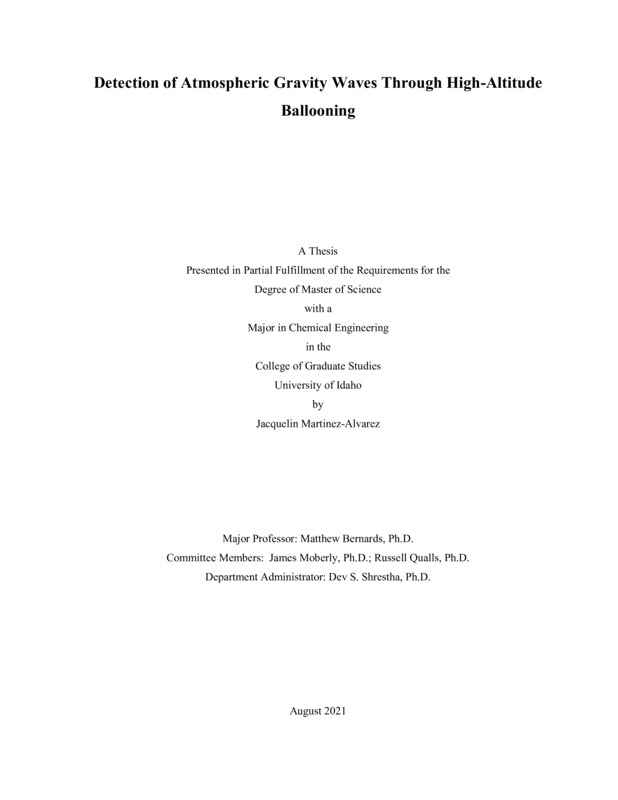Detection of Atmospheric Gravity Waves Through High-Altitude Ballooning
Martinez-Alvarez, Jacquelin . (2021-08). Detection of Atmospheric Gravity Waves Through High-Altitude Ballooning. Theses and Dissertations Collection, University of Idaho Library Digital Collections. https://www.lib.uidaho.edu/digital/etd/items/martinezalvarez_idaho_0089n_12166.html
- Title:
- Detection of Atmospheric Gravity Waves Through High-Altitude Ballooning
- Author:
- Martinez-Alvarez, Jacquelin
- Date:
- 2021-08
- Program:
- Chemical and Materials Science Engineering
- Subject Category:
- Chemical engineering; Atmospheric sciences
- Abstract:
-
Atmospheric gravity waves (AGWs) are transverse waves that propagate in all directions throughout the atmosphere. They arise from a multitude of sources such as: orography, fronts, and convection. AGWs are excellent transporters of energy and momentum, which influence atmospheric turbulence, temperature, and chemistry. Wave transport and the successive deposition of energy is an important component in atmospheric dynamics as they have a large impact on the spatial and temporal characteristics of the middle and upper atmosphere. As a result, they play a great role in daily weather and long-term climate fluctuations. However, the horizontal resolutions of global climate models lack the ability to resolve the scales of the important part of AGWs, and because of this, their contributions to global climate simulations are missed. Thus, their parameterization and quantification are essential for improving weather forecast models. This thesis focuses on the detection of AGWs through high-altitude ballooning. In December 2020, radiosondes were sent as payloads through the lower and upper atmosphere, up to about 30 km, collecting sounding profiles in South America, before, during and after a total solar eclipse. Half of the radiosondes were launched from Tolten, while the other half were launched from Villarrica, providing an opportunity to detect AGWs around the Andes mountains and during the total solar eclipse. Each radiosonde was launched an hour apart over 48 consecutive hours. Through the collection of wind and temperature profiles, and using Euler’s equations of motion, a wavelet-based method was used to decompose vertical profiles of horizontal wind into gravity wave packets. To parameterize the waves, intrinsic frequency, and horizontal and vertical propagation directions were determined using Stokes parameters. The detected AGWs were characterized into three main categories: AGWs caused by significant wind shears, mountain waves, and solar-eclipse induced waves. These results provide parameters for multiple sources of AGWs that can be useful for climate change mitigation strategies through improved climate models, which contribute to the quality of life for millions.
- Description:
- masters, M.S., Chemical and Materials Science Engineering -- University of Idaho - College of Graduate Studies, 2021-08
- Major Professor:
- Bernards, Matthew
- Committee:
- Moberly, James; Qualls, Russell
- Defense Date:
- 2021-08
- Identifier:
- MartinezAlvarez_idaho_0089N_12166
- Type:
- Text
- Format Original:
- Format:
- application/pdf
- Rights:
- In Copyright - Educational Use Permitted. For more information, please contact University of Idaho Library Special Collections and Archives Department at libspec@uidaho.edu.
- Standardized Rights:
- http://rightsstatements.org/vocab/InC-EDU/1.0/

